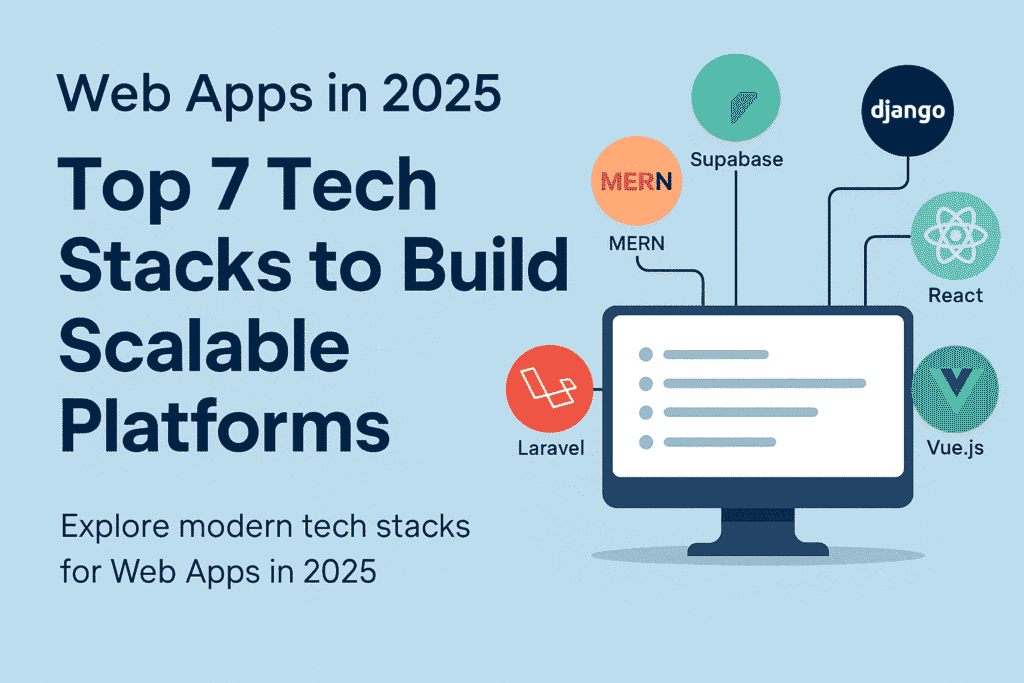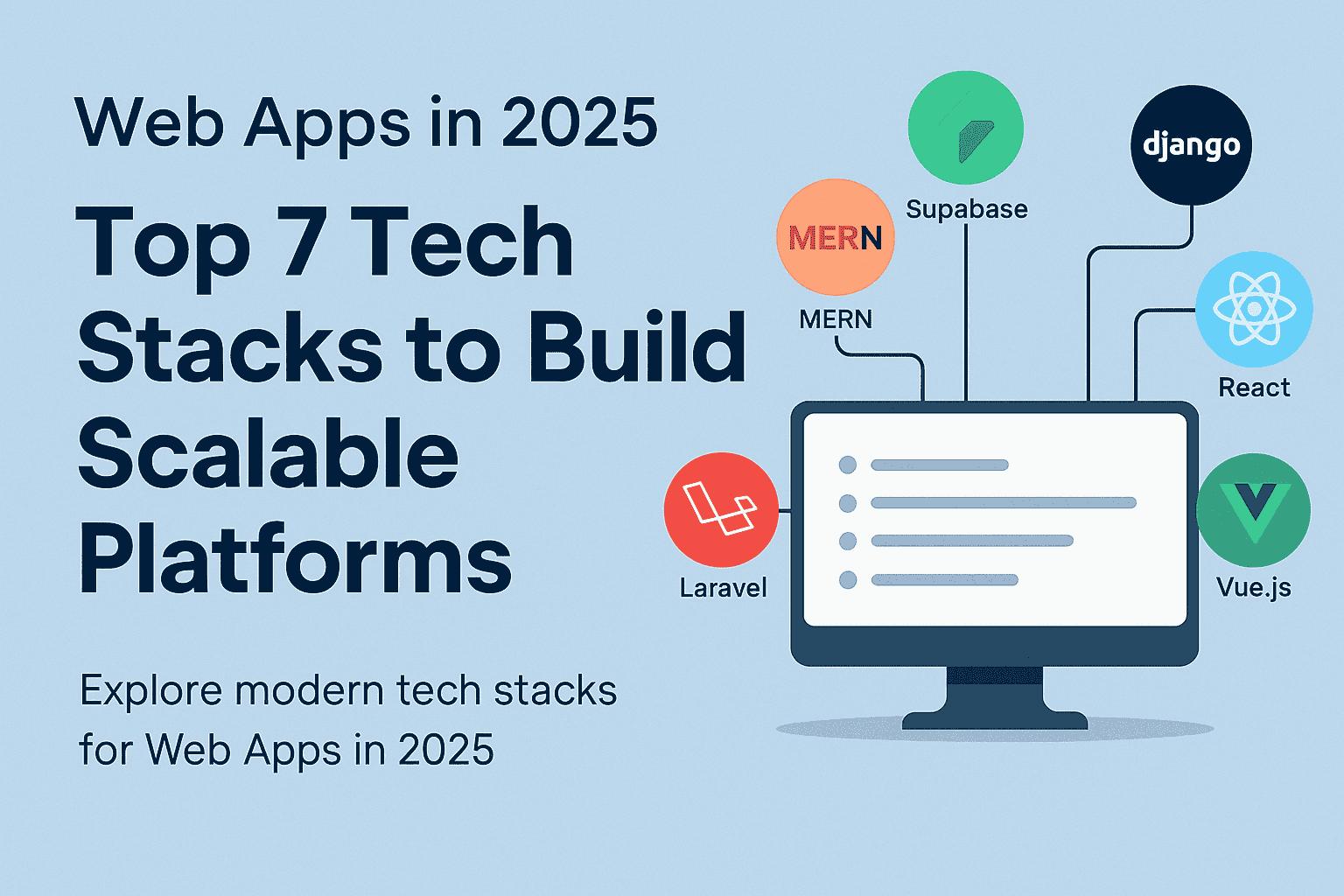Powerful 7 Tech Stacks for Scalable Web Apps in 2025

Top 7 Tech Stacks for Scalable Web Apps in 2025
Choosing the best tech stack for web apps in 2025 isn’t just about hype it’s about building fast, scalable, and maintainable software that can grow with your business. With the constant evolution of frameworks, databases, and deployment tools, it’s important to know what’s working right now.
In this blog, we’ll break down 7 top-performing tech stacks and explain when (and why) to use each one.
1. MERN Stack (MongoDB, Express.js, React.js, Node.js)
The classic MERN stack continues to be a favorite among startups and agencies for its flexibility and huge community support.
Learn more about MERN architecture from MongoDB’s official docs.
Why it works in 2025:
- Fully JavaScript-based (frontend + backend)
- Easy integration with REST and GraphQL
- Scalable using containerized environments like Docker
- Rich ecosystem for rapid development
Best for: MVPs, custom dashboards, SaaS platforms
Google’s Web Vitals should also guide how your stack supports user performance in 2025.
2. Next.js + Supabase
A modern alternative to traditional backend stacks, Next.js combined with Supabase allows server-side rendering, edge functions, and real-time database capabilities all in one setup.
Why it’s hot in 2025:
- Built-in API routes in Next.js
- Supabase replaces Firebase with SQL support
- Server Actions and App Router in Next.js 14
- Built-in Auth, storage, and row-level security
Best for: Scalable SaaS apps, e-commerce, internal tools
3. T3 Stack (Next.js, tRPC, Tailwind, Prisma)
The T3 Stack has exploded in popularity for TypeScript-first applications. It emphasizes full-type safety from client to database, and promotes fast iteration cycles.
Why devs love it:
- End-to-end type safety with tRPC
- Tailwind for modern, fast UI
- Prisma for fast, typed DB access
- Works perfectly with Vercel or Railway
Best for: Dev tools, admin panels, startups focused on speed
4. Jamstack (Next.js / Astro + Headless CMS + Static Hosting)
Jamstack remains powerful in 2025, especially with frameworks like Astro 4.0 and Next.js ISR (Incremental Static Regeneration) maturing.
Why it’s still relevant:
- SEO-friendly static pages
- Integrates easily with headless CMS (e.g., Sanity, Strapi, Contentful)
- Fast page loads, great Core Web Vitals
- Low server costs via Vercel, Netlify, or Cloudflare
Best for: Marketing websites, blogs, documentation portals
5. Flutter + Firebase (Web)
Yes, Flutter isn’t just for mobile anymore. With Flutter Web maturing and Firebase offering backend-as-a-service, this stack is ideal for apps with shared codebases.
Why it’s growing:
- One codebase for Android, iOS, and Web
- Firebase handles auth, database, functions, hosting
- Google-backed ecosystem with regular updates
Best for: Startups needing cross-platform apps
6. Laravel + Vue.js
Laravel continues to evolve with powerful tools like Laravel Breeze, Livewire, and Jetstream. When paired with Vue.js, it offers a clean, full-stack development approach.
Why it’s reliable:
- Built-in authentication and routing
- Excellent for monoliths and B2B apps
- Vue handles interactivity without complexity
Best for: CRMs, billing platforms, business portals
7. Django + React.js
This Python + JavaScript combo is still going strong. Django offers a robust backend with built-in admin, while React handles the frontend UI.
Why devs use it:
- Security-first architecture
- PostgreSQL, Redis, Celery integration
- REST or GraphQL support via Django REST Framework
Best for: Scalable enterprise apps, fintech, data-heavy platforms
How to Choose the Right Stack?
Ask yourself:
- Do you need fast delivery or long-term scalability?
- What’s your team’s core skill set?
- Will you need real-time updates?
- How important is SEO?
- Are you building a monolith or microservices?
There’s no “one stack fits all.” The best tech stack for web apps in 2025 depends on your app’s goals, timeline, and team.
FAQs: Best Tech Stack for Web Apps 2025
❓What is the most scalable tech stack in 2025?
Next.js + Supabase or MERN with microservices architecture are among the most scalable options in 2025.
❓Which stack is fastest to build MVPs?
The T3 Stack (Next.js + tRPC + Prisma) and MERN are great for rapid MVP development with strong community support.
❓Is Jamstack still relevant in 2025?
Yes. For content-heavy or SEO-focused sites, Jamstack with Astro or Next.js ISR remains a fast and efficient option.
❓Should startups use Firebase in 2025?
Firebase is great for quick setup, but for more complex use-cases, consider Supabase, custom backends, or serverless functions.
❓Can I scale a Flutter web app?
Flutter web is improving, but it’s still best for simpler web apps or when reusing code across mobile and web platforms.
Final Thoughts
2025 is all about performance, developer velocity, and scalability. Whether you’re launching a SaaS, building internal tools, or scaling to thousands of users—there’s a tech stack that fits.
Looking for expert help picking the right stack for your project?
Reach out to LogicNosh—we help businesses build, scale, and launch high-performance web apps that users love.








